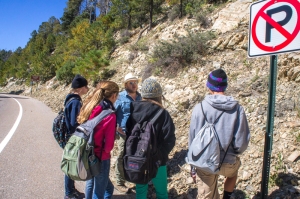
Freezing and frequent fires are both more prevalent in the Sky Islands than in Tucson. Sky Islands are the forest capped mountain ranges dotting the low lying desert sea of the southwestern United States and northern Mexico. Over the last two days, I helped to investigate which would contribute more to weathering: the fires or the freezes?
This project was the work of five Environmental Science students at Tanque Verde High School who spent their fall break attending the new University of Arizona Sky School, a residential science school located at the summit of Tucson’s most accessible Sky Island: Mount Lemmon. It was co-advised by myself (a doctoral candidate in Ecology and Evolutionary Biology) and Phil Stokes (a doctoral candidate in Geosciences). Needless to say, this project built substantially on Phil’s expertise, and I learned a lot.
For example, I learned that weathering is the process of rocks breaking down, while erosion is the transportation of those particles. I learned that having five students lean around a fire and watch intensely through their safety goggles as a crack in a rock widens visibly a millimeter feels like success.

To test the severity of weathering by freezing and by fire, we collected 3 types of rock, and subjected them to 4 treatments. The rock types were schist, quartzite, and granite. The treatments were repeated short freezing cycles, repeated short fire cycles, a long freeze, and a long burn. Rocks were soaked in warm water before treatments, and between freeze or burn cycles.
As the members of Team Tough Schist presented in the Second Sky School Symposium, ice and fire work differently on weathering rock. A very general explanation they provided was that water seeps into existing cracks, then expands when frozen, widening them. Fire, however, heats the many minerals in the rock, busting them apart and creating new cracks. This additional surface area opened by fire allows more weathering.
Armed with this understanding of weathering mechanisms, and the evidence of more cracks in the roasted rocks than the frozen rocks, Team Tough Schist also concluded that schist is not so tough. Anyone who has picked up the papery flakes laced with mica may have also observed this. And when those papery layers curl up when expanding due to heat, they stay crinkled like a book that once wetted, never lies perfectly flat. As you might also imagine, repeated freeze-thaw cycles wedge cracks wider and wider more than one long freeze. But one long and intense fire may expand and crack a rock more than repeated short fires.

Although overall fire was determined by Tough Schist to be a more severe weathering agent, freezing occurs every year all over the tops of Sky Islands, and fires near any given rock are less frequent, even under historical more frequent fire regimes. So they left their audience with further questions: Which weathering agent, ice or fire, should be contributing more to weathering processes on Mount Lemmon overall?
On a final note, I was obviously disappointed none of the students were fans of George R.R. Martin, given their choice of research question.

